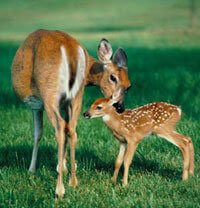Hunting might have been necessary for human survival in prehistoric times, but today most hunters stalk and kill animals merely for the thrill of it, not out of necessity. This unnecessary, violent form of “entertainment” rips animal families apart and leaves countless animals orphaned or badly injured when hunters miss their targets.

Quick kills are rare, and many animals suffer prolonged, painful deaths when hunters severely injure but fail to kill them.
A member of the Maine BowHunters Alliance estimates that 50 percent of animals who are shot with crossbows are wounded but not killed. A study of 80 radio-collared white-tailed deer found that of the 22 deer who had been shot with “traditional archery equipment,” 11 were wounded but not recovered by hunters.
A British study of deer hunting found that 11 percent of deer killed by hunters died only after being shot two or more times and that some wounded deer suffered for more than 15 minutes before dying.
Twenty percent of foxes wounded by hunters are shot again; 10 percent manage to escape, but “starvation is a likely fate” for them, according to one veterinarian.
Hunting also disrupts migration and hibernation patterns and destroys families. For animals such as wolves and geese, who mate for life and live in close-knit family units, hunting can devastate entire communities.
The fear and the inescapable, earsplitting noises from the gunfire and other commotion that hunters create cause hunted animals to suffer tremendous stress. This severely compromises their routine and their eating habits, making it hard for them to store the fat and energy that they need to survive the winter. Loud noises can also disrupt mating rituals and can cause parent animals to flee their dens and nests, leaving their young vulnerable to natural predators.
